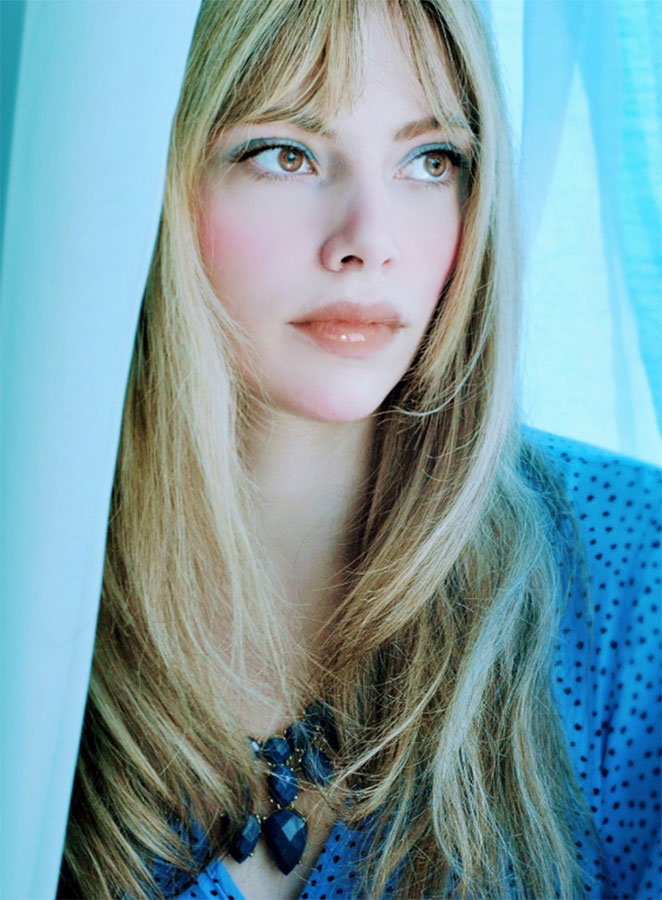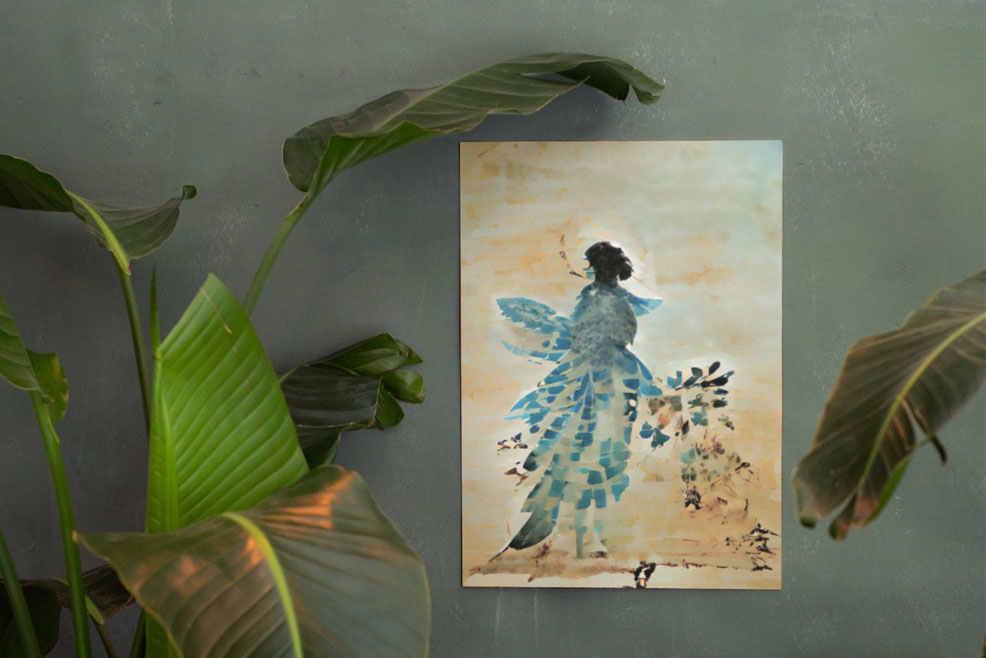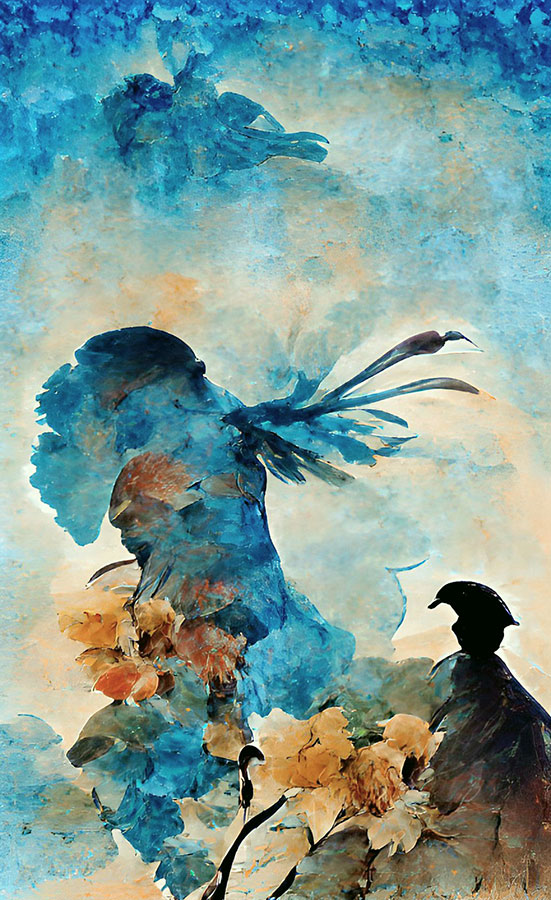I view life as a complex tapestry woven with intricate threads of spoken and unspoken narratives. This understanding guides me in my art, where I strive to capture not just the visible but also the intangible—those elusive aspects of experience
that often go unnoticed.
Genova, Italy
@helenabarbagelata | www.giovaniartisti.it
INTERVIEW
In your works, you often use symbolism and focus on colors with a limited palette. How did you come to develop your style?
My artistic style is shaped by a thoughtful engagement with symbolism and color theory, emphasizing art’s power to transcend mere aesthetics and reveal deeper truths. This approach drives me to develop a visual language that distills my themes through a carefully selected color palette. Giorgio de Chirico’s idea that “the essence of the world is mystery” parallels my use of limited colors to evoke enigma and depth, reflecting the metaphysical nature of my work. Similarly, Beethoven’s strategic use of select musical keys aligns with this concept. Guido d’Arezzo’s notion of “musical colors” illustrates how key relationships and modulations in music, much like a painter’s limited palette, explore greater artistic subtleties. Beethoven’s key choices create a rich, nuanced musical narrative, evoking specific moods much like an artist’s limited palette creates depth, furthering the interpretative possibilities of a piece.

Tell us, how is an idea for a new project or series born? Do you incorporate new mediums in the process, or do you know in advance that you want to combine, for example, painting and sculpture?
The genesis of a new project or series is often an organic process rather than a rigidly defined plan. I approach each project with a sense of exploratory freedom, allowing my ideas to evolve naturally. This adaptability is akin to the Jewish mystical tradition, which emphasizes the continual process of creation and transformation. In practice, this means that while I may initially conceive a project with a specific medium in mind, I remain open to integrating new forms and techniques as the project develops. The intersection of painting and sculpture, for instance, arises from an ongoing dialogue between different artistic practices rather than a premeditated strategy.

You have quite a few awards. Which of them has been the most significant for you?
While I am honored by the recognition my work has received, I believe that awards are not the ultimate measure of artistic value. For me, the true value of art lies in its ability to foster dialogue, experience, and exchange. The process of connecting with others through my work and engaging in meaningful conversations about art is far more fulfilling than any accolade. It is through these interactions and shared experiences that the true impact of art is realized, reinforcing the idea that communication and connection are at the heart of artistic expression.

Speaking of presenting your art, you have had numerous solo and group exhibitions worldwide. How did audiences react to your works? Have you also presented your art in various media?
The reception of my art in solo and group exhibitions has varied widely, reflecting the diverse perspectives and interpretations of audiences around the world. As Emmanuel Levinas eloquently stated that the face of the other is the source of all ethics, highlighting the importance of authentic encounters with others. My work aims to create such encounters, prompting viewers to engage deeply with the themes presented. Presenting my art across different media has also been a significant aspect of my practice. This exploration is rooted in the idea that art should transcend traditional boundaries. By utilizing various forms of media, I seek to reveal new dimensions of my artistic vision. This multifaceted approach allows me to connect with diverse groups, fostering a richer and more inclusive dialogue through my art.

Helena, which exhibition opened up new perspectives for you and made you feel like a truly serious artist?
The exhibitions that have most profoundly impacted me were not the ones where my work was displayed, but rather those where it was denied the chance to be seen. Several pieces, tragically vandalized by fascist and anti-Semitic groups, became symbolic in their own right. One painting, for instance, was ripped in half, and rather than repair it, I chose to leave it as it is. The damage itself now forms part of the narrative, reflecting not just the fragility of art but the resilience of its message.
In a sense, these pieces—marked by their destruction—have become integral to my artistic journey, embodying both the loss and the enduring spirit of creativity.
What opportunities have opened up for you as a member of SOJA?
Joining SOJA has provided a wealth of opportunities for growth and collaboration. Artistic organizations and communities are more than just networks; they are vital ecosystems that nurture creativity and foster meaningful exchanges, there is this Aramaic phrase from the Talmud, כל ישראל ערבים זה לזה, which translates to “All of Israel are responsible for one another.” This principle underscores the profound interconnectedness and mutual support that form the backbone of any thriving community. Organizations provide artists a space where ideas flourish and artistic visions are refined through collaborative dialogue and mutual encouragement. Their true value lies in their ability to create a supportive environment where artists can thrive together. By upholding the principle that we are all responsible for one another, they help elevate our collective achievements and enrich our shared journey in the global art community.

What advice would you give to aspiring artists? How can they find themselves and perceive opportunities for advancement in the art world?
For aspiring artists, I would offer the advice encapsulated in Dante Alighieri’s observation that “the darkest places in hell are reserved for those who maintain their neutrality in times of moral crisis.” Embrace your unique vision and remain resolute in your pursuit of artistic truth, even amidst challenges.
Be brave, both conceptually and ethically, in your work and in your life.
Recognize that opportunities often arise from an active engagement with the world around you and a willingness to adapt and evolve.
By remaining open to diverse experiences and perspectives, you can navigate the complexities of the art world and discover your own path to advancement. Courageously push the boundaries of your creativity and stand firm in your convictions, for it is through this boldness that truly transformative art is born.